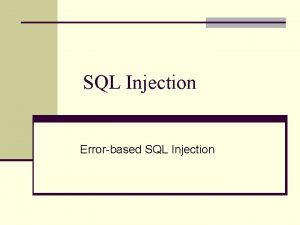Evaluation Of Chemomechanical Impacts Of CO 2 Injection


- Slides: 2

Evaluation Of Chemo-mechanical Impacts Of CO 2 Injection To Depleted Oil Reservoirs. Benjamin Adu-Gyamfi, William Ampomah, Qian Sun, Robert Will, Jiawei Tu Petroleum Recovery Research Center, New Mexico Institute of Mining and Technology Background Objectives a) Carbon Capture, Utilization, and Storage (CCUS) is one a) To present a rigorous approach in evaluating the of the technologies being relied upon to avert global warming. impacts of CO 2 injection in CO 2 sequestration operations b) In 2003, the U. S. Department of Energy (DOE) set up in a depleted Morrow B sandstone of the FWU by seven regional partnerships across the North American Region to study the technologies and strategies of CO 2 including mechanical responses to the CO 2 sequestration and CO 2 enhanced oil recovery (EOR). sequestration aspect of CCUS. c) The Southwest Regional Partnership (SWP), which works with the operator of the Farnworth Field Unit b) To evaluate the effects of chemo-mechanical alteration (FWU) located in Ochiltree County, Texas, has of formation properties on CO 2 storage mechanisms in conducted several studies in the FWU. d) The SWP studies include numerical simulations to the Morrow B sandstone reservoir using coupled evaluate the effects of coupling hydrodynamical and numerical hydrodynamical, geochemical, and geochemical models on CO 2 storage and the petrophysical properties of the Morrow B sandstone. geomechanical simulation models. Other studies have used coupled hydrodynamical and geomechanics simulation models to evaluate the(1) c) To evaluate the long-term CO 2 storage capacity of the(2) integrity of the caprocks of the FWU. Methodology Future Directions Adopt simulation model This work serves as a benchmark for future CO 2 sequestration and CO 2 -EOR studies. Set up inverted five-spot pattern Conduct history matching Set up baseline model (hydrodynamical model) Modeled 3 trapping mechanisms Set up coupled hydrodynamical and geomechanical (HGM) model Run 1000 -year prediction after wells shut-in Acknowledgement s Set up coupled hydrodynamical and geochemical (HGC) model Set up coupled hydrodynamical, geochemical and geomechanical (HGCM) models a) Future studies will investigate the effects of coupled hydrodynamical, geochemical and geomechanical models on CO 2 sequestration in the inverted five-spot pattern with a flux boundary and a full-field application. Run 1000 -year prediction after wells shut-in Funding for this project is provided by the U. S. Department of Energy's (DOE) National Energy Technology Laboratory (NETL) through the Southwest Regional Partnership on Carbon Sequestration (SWP) under Award No. DE-FC 2605 NT 42591. Run 500 -year prediction after wells shut-in (3) (4)

Evaluation Of Chemo-mechanical Impacts Of CO 2 Injection To Depleted Oil Reservoirs. Benjamin Adu-Gyamfi, William Ampomah, Qian Sun, Robert Will, Jiawei Tu Petroleum Recovery Research Center, New Mexico Institute of Mining and Technology Results Mineral precipitation (5) Permeability and porosity alterations Porosity change in geomechanical model Permeability change in geomechanical model Porosity change in geochemical model Lay er 1 Lay er 3 Lay e r 2 Lay e r 4 Conclusion s Mineral dissolution (6) a) In the four models, all of which used fixed boundary conditions, most CO 2 was stored as free gas in the reservoir, followed by residual gas, dissolution in oil, and aqueous phases. b) The dissolution of calcite was faster than precipitation and therefore, resulted in no net formation of carbonate mineral. c) The changes in rock properties due to the effects of variations in stress that are reflected in coupled hydro-geomechanical models are observed to have more influence on the porosity and permeability properties than the chemical reactions. d) Again, the changes in rock properties in coupled hydrogeomechanical models are observed to have more influence on the CO 2 injectivity. e) In CO 2 sequestration and/or EOR storage capacity simulation studies, it is recommended to model coupled hydrogeomechanics to ensure a more realistic responses to the CO 2 injection. Reference s (7) [1] IPCC (2007): Climate Change 2007: The Physical Science Basis, contribution of Working 591 Group I to the Fourth Assessment Report of the IPCC, in: Solomon, S. , Qin, D. , Manning, 592 M. , Marquis, M. , Averyt, K. , Tignor, M. M. B. , Le. Roy Miller, J. , H. , Chen, Z. (Eds. ). 593 Cambridge University Press, Cambridge and New York, 594 pp. [2] Mac Dowell, N. , Fennell, P. , Shah, N. et al. The role of CO 2 capture and utilization in mitigating climate change. Nature Clim Change 7, 243– 249 (2017). https: //doi. org/10. 1038/nclimate 3231 [3] Ampomah, W. , Balch, R. , Cather, M. , Rose-Coss, D. , Dai, Z. , Heath, J. , Mozley, P. (2016). Evaluation of CO 2 Storage Mechanisms in CO 2 Enhanced Oil Recovery Sites: Application to Morrow Sandstone Reservoir. Energy and Fuels, 30(10), 8545– 8555. https: //doi. org/10. 1021/acs. energyfuels. 6 b 01888 [4] Kutsienyo, E. J. , Ampomah, W. , Sun, Q. , Balch, R. S. , You, J. , Aggrey, W. N. , & Cather, M. (2019, June 3). Evaluation of CO 2 -EOR Performance and Storage Mechanisms in an Active Partially Depleted Oil Reservoir. Society of Petroleum Engineers. doi: 10. 2118/195534 MS [5] Sun, Q. , Ampomah, W. , Kutsienyo, E. J. , Appold, M. , Adu-Gyamfi, B. , Dai, Z. , & Soltanian, M. R. (2020). Assessment of CO 2 trapping mechanisms in partially depleted oil-bearing sands. Fuel, 278, 118356. https: //doi. org/10. 1016/j. fuel. 2020. 118356 (8)



